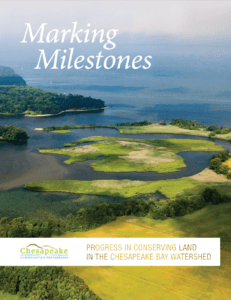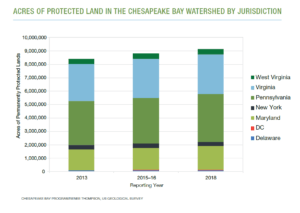
Reflecting on a decade of collaborative progress in the Chesapeake Bay watershed
Jonathan Doherty, National Park Service Chesapeake Bay Office and Chesapeake Conservation Partnership steering committee member“LAND. It’s as important as air but we often take it for granted. Land grows our food, cleans our water, and sometimes even takes our breath away with its beauty. Land anchors life.”
 This is how a major new report from the Chesapeake Conservation Partnership, a coalition of dozens of land conservation organizations and agencies, begins. Released in September, Marking Milestones: Progress in Conserving Land in the Chesapeake Bay Watershed is the most comprehensive survey of land conservation and funding in the Chesapeake Bay region in a decade. And that’s no small matter, as over a million acres have been permanently protected in the Chesapeake watershed since 2010.
This is how a major new report from the Chesapeake Conservation Partnership, a coalition of dozens of land conservation organizations and agencies, begins. Released in September, Marking Milestones: Progress in Conserving Land in the Chesapeake Bay Watershed is the most comprehensive survey of land conservation and funding in the Chesapeake Bay region in a decade. And that’s no small matter, as over a million acres have been permanently protected in the Chesapeake watershed since 2010.
Marking Milestones showcases the tremendous value of Chesapeake watershed–64,000 square miles in six states and Washington DC feeding the largest estuary in the United States–and its rich conservation legacy. The region’s natural and cultural heritage and recreation opportunities have spawned more than a century of progress, resulting in: more than 4 million acres of state-owned parks, forests, and wildlife management areas; over 2.1 million acres of privately owned farm, forest, and historic lands protected through conservation easements; hundreds of nature preserves and cultural sites managed by nongovernmental organizations; over 1,300 public access sites along rivers and the Chesapeake Bay; and 57 units of the National Park System, 17 national wildlife refuges, and 2 national forests.
These results are the work of landowners, citizens, nongovernmental organizations, and government agencies, seeking to improve and preserve the Chesapeake region’s quality of life. Marking Milestones highlights 18 conservation success stories from last year. It also points out the significant financial investments necessary for conserving the lands upon which we depend — and the return on investment derived from them.

Chart depicting continued progress in Chesapeake watershed land protection. Conservation partners are 68% toward achieving the goal of protecting an additional 2 million acres by 2025. (Image: Chesapeake Conservation Partnership)
The report documents where the Chesapeake Conservation Partnership stands in achieving the Chesapeake Bay Watershed Agreement goal to protect an additional 2 million acres by 2025. The agreement was signed in 2014 by the governors of Delaware, Maryland, New York, Pennsylvania, Virginia, and West Virginia, the mayor of the District of Columbia, the administrator of the U.S. Environmental Protection Agency on behalf of the federal government, and the chair of the Chesapeake Bay Commission. As of the end of 2018, Partnership members have conserved over 1.3 million acres toward achieving the 2025 goal; 68% of the way there.
Marking Milestones also provides detailed information on the status of land protection funding programs in the region in recent fiscal years — the first survey of its kind in a decade. “The six states within the Chesapeake Bay watershed have some of the leading land conservation programs in the nation,” states Ann Swanson, Partnership Steering Committee member and Executive Director of the Chesapeake Bay Commission. “Collectively, these states invested more than $300 million in just one recent fiscal year. The federal government also plays an important role, though at a smaller scale. This report showcases the impact of these efforts and highlights the ongoing commitment of landowners to conserve their lands. But it also documents that landowner interest far exceeds available funding. We should address this head on by growing our state and federal financial resources and technical assistance. After all, conserving land is one of the most sure-fire ways we know of to ensure the health of our watershed.”
In fact, the report calls for a renewed urgency in land conservation. Scientists around the globe warn us that action must be taken to avert major disruptions to our quality of life. It is not too late, but broad, concerted action must be taken now and over the next decade. Land protection is not the only solution, but scientists point to protecting 30 percent of the planet by 2030 as an essential goal.
This reaffirms steps the Partnership has taken over the past several years to set out long-term conservation goals related to multiple values: farms, forests, habitat, heritage and human health. Protecting the most valuable lands, where multiple values overlap, would lead to conserving half the watershed. Marking Milestones outlines protecting thirty percent by 2030–or an additional 3.1 million acres–as the first step.
“America’s great estuary, with all the benefits it provides, must be managed as a system,” says Thomas Lovejoy, Senior Fellow at the United Nations Foundation, Professor at George Mason University, and often referred to as the “Godfather of biodiversity. “The pioneering and farsighted Chesapeake Conservation Partnership report spotlights the remarkable achievement of protecting 22% of the land in the watershed. Yet that is not enough. Emerging scientific consensus recognizes the need to protect 30% of the watershed by 2030 and 50% by 2050 – setting a visionary example for the world on how to save the environment and humanity.”

Historic Malvern Hill Farm, a 2018 conservation success story from Virginia. (Photo: Capital Region Land Conservancy)
A key to the success of land conservation in the Chesapeake is the long history of collaboration across jurisdictional boundaries. People working in this field are used to regional goal-setting and sharing data and analyses. They do this work at multiple scales, carrying out land conservation projects at the parcel level, organizing in one or more of the dozens of regional conservation partnerships within the watershed, and collaborating at the watershed-wide scale through the Chesapeake Conservation Partnership to help advance a holistic long-term approach and shared strategies.
Conserving an additional 3.1 million acres over the next decade is ambitious, and will require new investment strategies. But even within the Chesapeake watershed there are already active regional partnerships advancing similar goals that contribute to the whole. “Delmarva Oasis,” coordinated by the Eastern Shore Land Conservancy, seeks to conserve 50 percent of the Delmarva Peninsula, the broad rural and natural lands between the Chesapeake Bay and the Atlantic, by 2030. West of the Chesapeake in just the nine-county region served by Virginia’s Piedmont Environmental Council, landowners have conserved more than 400,000 acres through conservation easements since 1972. That work is continuing today. Just a bit farther west beyond the Shenandoah Valley, the USDA Forest Service recently announced the addition of a 4,644.5 acre property to the George Washington and Jefferson National Forests. The land in Botetourt County, Virginia helps protect the headwaters of the James River, a tributary of the Chesapeake Bay.
Land conservation successes happen virtually every day somewhere in the 64,000 square mile watershed. Landowners, land trusts, communities, and agencies collaborate to protect farms and forests, conserve wildlife habitat, create trails, expand public access to rivers and the bay, save historic treasures. All of these actions are vital to maintaining and enhancing the quality of life in Chesapeake watershed communities. The risks to that quality posed by climate change, unplanned development, inadequate access to the outdoors, and more are imposing. But as Marking Milestones lays out, the Chesapeake watershed has a significant conservation heritage, substantial capacity for carrying out conservation, a tradition of collaboration, and a clear set of goals where progress is happening. The challenge is now to take this to the next level.

White Horse Mountain, a 2018 conservation success story profiled in Marking Milestones. (Photo: (c) William McFarland; courtesy Mcfarlandphoto.net)
About the Chesapeake Conservation Partnership:
The Chesapeake Conservation Partnership is a coalition of diverse organizations and agencies engaged in land conservation and related fields within the Chesapeake Bay watershed. Partners seek to extend the conservation of large landscapes throughout the region to benefit multiple values, including economic sustainability; scenic, historic and cultural heritage; working lands; important wildlife habitat; water quality and supply; and overall quality of life. The Partnership is co-convened by the Chesapeake Conservancy and the National Park Service Chesapeake Bay Office.
